|
Yeşilırmak
vadisi boyunca Tokattan doğuya, Almus yönüne giden yol 13
kilometre sonra küçük bir kavşaktan dağlara doğru döner.
Derin vadiler, kuru dere yatakları, sarp yamaçlardan kıvrılarak
ilerleyen yol kel bir tepenin yamacına kurulmuş orta büyüklükte
bir köye ulaşır. İlk bakışta tipik bir Anadolu köyü
izlenimi veren Tokat merkeze bağlı
Nebi köyü, avlu içinde |
|
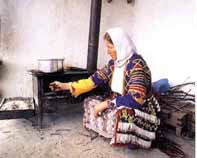
|
|
düz ya da kiremit damlı evleri, her biri
bir tarafa atılmış iş aletleri ve çitlerle çevrilmiş bahçeleriyle
ziyaretçilerine, başka Anadolu köylerinden çok da farklı görünmez.
Fakat, köy içinde ilerlemeye başlayınca, evlere girip çıkan,
bahçede çapa yapan, çeşmeden su taşıyan allı, yeşilli, morlu
rengarenk giysileriyle kadınlar göze çarpar. Her biri biraz sonra
folklor yarışmasına çıkacak gibi rengarenk ve göz alıcı
elbiseler giyen kadınlar sadece günlük işlerini yapmaktadırlar. |
|
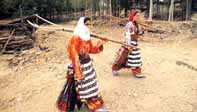
|
|
Erkeklerin
pantalon, ceket, gömlek gibi sıradan kıyafetler giydiği Nebi köyünde
kadınlar, çocuk, genç, yaşlı ayrımı gözetmeksizin el işiyle
yapılan ve herkesin genellikle kendisinin dikip nakışladığı
üçbeş adı verilen kıyafetler giyiyorlar. Üst üste
giyilen ve birkaç parçadan oluşan üçbeşin hazırlanması
aylarca sürüyor.
Bir
kadın hiç durmadan çalıştığında yaklaşık 300 milyon lira
harcayarak üç ayda tüm parçaları tamamlayabiliyor. Fakat, bu işlemler
genellikle uzun kış gecelerinde ya da diğer gündelik işlerden
kalan zamanlarda yapılıyor.
Üçbeşin
kadınlar için bir önemi daha var. Çok emek isteyen bu özel ve
yerel giysiyi tek başına hazırlayan genç kızlar artık reşit
sayılıyor.
|
|

|
Nebi
köyünde, Türkmen geleneklerine sıkı sıkıya bağlı olan
sadece kıyafetler değil, örf ve adetler de yüzyılların izini
taşıyor. Köyde misafir olduğumuz günlerde, bu örf ve adetlerin
en yoğun yaşadığı köy düğünlerinden birine tanık olduk.
Tabii, sözünü |
|
ettiğimiz
geleneksel
ritüeller, düğün gününün çok öncesinden, kız isteme
ile başlıyor.
Kız
isteyecek olan müstakbel dünür, kendi gitmeden önce kız evine
aracı göndererek nabız yokluyor. Olumlu sinyaller alınırsa erkeğin
anne ve babası tam üç defa kız istemeye gidiyor. Ne de olsa kız
evi naz evi. Sonunda söz kesilip ilk adım atılıyor.
İkinci
aşama nişan. Köyün tüm kadın ve erkekleri kız evinde toplanıyorlar.
Evlenecek kız ve erkeğin babaları, köy büyüğü ve orada
bulunanların önünde diz çöküp birbirlerine oğlan ile kızı
nişanladıklarını yüksek sesle ilan ediyorlar. |
|
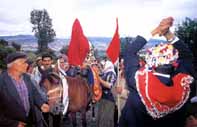
|
|
Şekerler
ezilip şerbetler içilmeden önce gelin tüm davetlilerin elini öpüp
bir kenarda ayakta bekliyor. Sonra sıra takı merasimine geliyor.
Erkekler para, kadınlar da giysi hediye ediyorlar.
Evliliğin
en son ve büyük töreni düğüne gelince... Genellikle üç gün
süren düğünün başlangıcı, damadın evinin damına yüksek
bir direğe bayrak çekilerek ilan ediliyor. Nebi köyünde düğünlerde
davul zurna çalınmıyor. Rivayetler muhtelif, ama en çok inanılan,
davul zurna çalmanın bir uğursuzluğa yol açacağı... Bu yüzdlen
halay ve oyunlar saz eşliğinde yapılıyor. Kadınlar ve
erkeklerin karışık olarak oynadığı oyunların en fazla tercih
edileni ellik ve semah. |
|
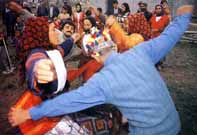
|
|
Düğün
günü, en yeni kıyafetlerini giyip renkli boncuklar takan kadınlar,
güneşin tüm renklerini taşıyan üçbeşleriyle adeta
birbirleriyle yarışıyorlar. Anadolunun birçok yerinde olduğu
gibi, düğünler burada da bir sonraki damat ve gelin adaylarını
belirlemek için en uygun ortam.
Evlenen
çiftler aynı köydense düğünler daha canlı oluyor. Gelin beyaz
gelinlik ve duvak yerine kendi el emeği olan üçbeşini giyip başına
kırmızı yazma örtüyor. Dışarıdan alınan gelinler ise köy sınırına
kadar beyaz gelinliğiyle gelse de, köye girmeden önce üçbeş
giymek zorunda. |
|
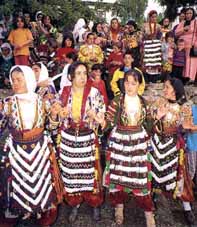
|
|
Genellikle
takım elbise giyen damatlar, başlarına honcuklu başlık, sırt
ve omuzlarına da kırmızı eşarp takıyorlar.
Yenilip
içilip eğlenilerek üç gün süren düğün, gelinin damat evine
getirilip hediyelerin verilmesiyle bitiyor. Düğünün son adeti de
ertesi sabah, gerdeğe giren damadın arkadaşları tarafindan
derede yıkanması.
Orta
Asyadan getirdikleri Türkmen kültürlerini yüzyıllardır
koruyan Nebi köylüleri, düğün sonrası, tekrar günlük işlerine
dönerler. Bir sonraki düğüne kadar... |
|

|
|
|
|
The
road leading east
from Tokat towards |
|
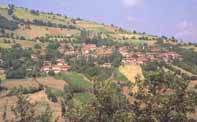
|
|
Almus
runs through the valley of the Yeşilırmak river, and at a small
crossroads 13 km from the city takes a turnoff into the mountains.
Winding through deep valleys, over dry riverbeds and up steep
slopes, it takes you to a medium sized village set on a bare
hillside. At first Nebi seems like a typical Anatolian village its
cottages with flat or tiled roofs set in yards scattered with
agricultural tools, and fenced gardens. |
|
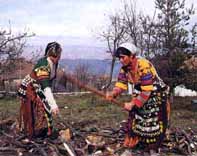
|
|
But
when you begin to wander around the village, you are struck by the
brilliantly colored red, green and purple clothing of the women
going in and out of their houses, hoeing the gardens, or carrying
water from the fountain. Each one looks as if dressed to enter a
folk dancing competition rather than merely go about their daily
chores.
While
the men are dressed in ordinary shirts, jackets and trousers, the
girls and women of all ages wear the traditional costume known as
üçbeş, which most sew and embroider themselves.
The üçbeş consists of
several |
|
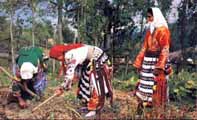
|
|
garments
worn one on
top of the other. A complete üçbeş takes three months in all to
make, at a cost of around 300 million Turkish lira (about 600 US
dollars). The women work at sewing and embroidery in their spare
time from domestic chores and during the winter months when there is
less outside work to he done.
The
üçbeş has further significance for girls, because they are
regarded as reached marriageable age when they have acquired the
skill to make an entire üçbeş costume without assistance from
their elders.
In
Nebi it is not only the costumes that reflect the strong sense of
Tiirkmen tradition. Many other customs dating hack
centuries are still |
|
alive here,
and
this is particularly evident at weddings, one of which we witnessed
during our visit. Of course the customs relating to weddings begin
long before the event itself with the request for the girls hand
in marriage. The prospective groom first sends a
member of his |

|
|
family
to sound
out the situation, and ifthe response is encouraging his mother and
father visit the girls family no less than three times to repeat the
request before the show of reluctance is dropped and the promise of
marriage is given.
The
second stage is the engagement, when all the men and women of the
village gather in the girls house. The fathers of the couple kneel
down in front of the village elders and other guests and declare
their son and daughter to be engaged. Then the bride-to-be
kisses the hand |
|
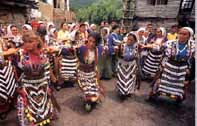
|
|
of
all the guests
and stands waiting at one side while the guests are served with the
sweet drink known as şerbet. Then it is time for the ceremony of
exchanging gifts, the men giving money and the women articles of
clothing.
The
final and most elaborate ceremony is the wedding itself, which
usually lasts three days. The beginning of the wedding is announced
by the groom raising a flag on a large pole on the roof of his
house. Unlike most Turkish weddings, drums and the pipes known as
zurna are not played in Nebi. Many different reasons are given for
this custom, but the general consensus is that it is unlucky.
Instead the guests dance to the music of the saz a long-necked
instrument with three pairs of strings. Women and men dance
together, the most popular dances being the ellik and semah. |
|
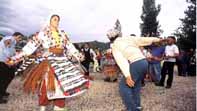
|
|
The
women dress up in their newest clothes in every color of the rainbow
and colored head jeweler, as if rivaling one another to produce the
most dazzling effect. As elsewhere in Turkey weddings are the best
opportunity for other unmarried young people to display their charms
to prospective spouses.
If
the couple being married both come from Nebi then it is a chance to
see traditional wedding celebrations at their most vibrant. The
bride wears an üçbeş and veil she has made herself. If the bride
is from another village and arrives in a white wedding dress, then
she must change into an üçbeş before entering Nebi. The groom
generally wears a suit, conceding to tradition by wearing a beaded
headdress and a red shawl over his shoulders. |
|
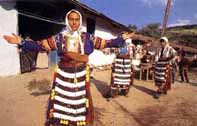
|
|
The
feasting and entertainments last for three days, ending when the
bride is escorted to the house of her husband and gifts are
exchanged. On the day after the nuptial night, the new husband is
washed in the stream by his friends.
When
the wedding is finally over the inhabitants of Nebi, who have
preserved the Türkmen traditions they brought to Anatolia from
Central Asia many centuries ago, return to their daily routine until
the next occasion. |
|